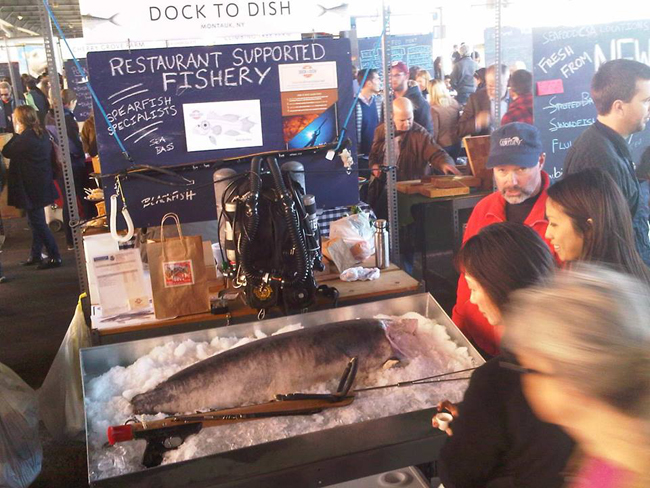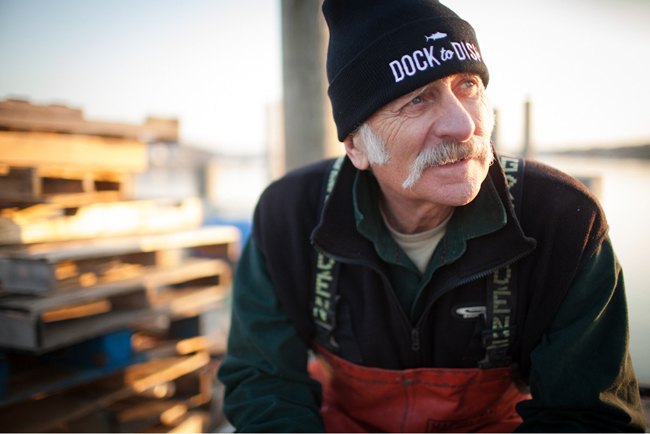A sampling of results and impacts from recently completed New York Sea Grant's extension and education initiatives.
<< back to NYSG Success Stories introduction page
2013 Projects Impact New York’s Coastal Resources
Ithaca, NY, April 4, 2014 - New York Sea Grant has issued a series of
impact statements for projects completed in 2013. The success of these outreach projects—made possible by collaborating
with national, state, regional, and local partners—shows how Sea Grant’s
depth of programming can benefit NY’s shoreline regions and have a
profound impact on its coastal communities and economies. They include:
- New York Sea Grant-organized Harmful Algal Bloom (HAB) workshops connected diverse stakeholders with HAB science experts to help mitigate the environmental and economic impacts of HAB outbreaks.
- New York Sea Grant-developed information is helping coastal property owners and communities evaluate living shorelines as an erosion control option.
- New York Sea Grant’s Clean & Safe Boating Education Campaign sets the model for keeping the public current on required safety equipment, environmentally-sound boating practices, and methods to reduce the transport of invasive species.
- A New York Sea Grant-initiated project will help more Americans with disabilities access Hudson River waterfront areas.
- New York Sea Grant-encouraged initiatives are increasingly incorporating New York seafood products into local food systems and strengthening NY’s commercial fishing businesses.
- New York Sea Grant Trawl Design Workshops have helped fisheries managers and commercial trawlers improve existing programs and design new initiatives.
- Teaching students about the environment and having them conduct hands-on
stewardship projects is helping to create an informed citizenry for the
future.
- NYSG NEMO project informs and equips municipalities to implement sustainable and cost-effective stormwater management programs.
- The New York Sea Grant waterfront steward program is expanding its educational impact and geographical outreach to help boaters slow the spread of aquatic invasive species.
- New York Sea Grant programming provides educators with successful strategies for implementing Long Island Sound concepts into existing curricula.
Below, you will find NYSG's individual Extension Impact Statements for 2013. You can also download these impacts statements as an entire collection or in a two-page summary:
- 2013 Project Summaries Show Impact on Coastal Waters, Communities, Youth, Economy & Educators (pdf) [11 pp.]
- New York Sea Grant Impacts (pdf) [2 pp.]
Healthy New York Coastal Ecosystems
NYSG Developing the Next Generation of Great Lakes Stewards (pdf)
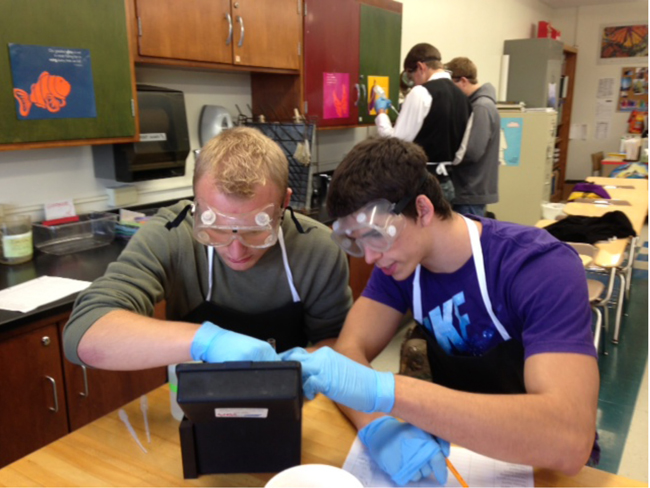
New York Sea Grant's coastal education training efforts have resulted in teachers getting students out in the Great Lakes shoreline environment to clean-up beaches and waterways, take and test water samples, work on eliminating invasive species and teach community members about the importance of properly disposing of unwanted or unused medications. The high school students pictured here test water they collected as part of a stewardship education activity (Photo: Kim Linkinhoker).
For more "NYSG Great Lakes Coastal Youth Education" news, click on the "News/Topics" section in the left-hand side bar at www.nyseagrant.org/cyeducation.
A NYSG-produced fact sheet as well as promotional pieces encouraging interested citizens to learn simple ways they can be wise coastal stewards can be found at www.nyseagrant.org/unwantedmeds.
NYSG Teach-the-Teacher Training Extends Great Lakes Education to 12,000 NY Students (pdf)
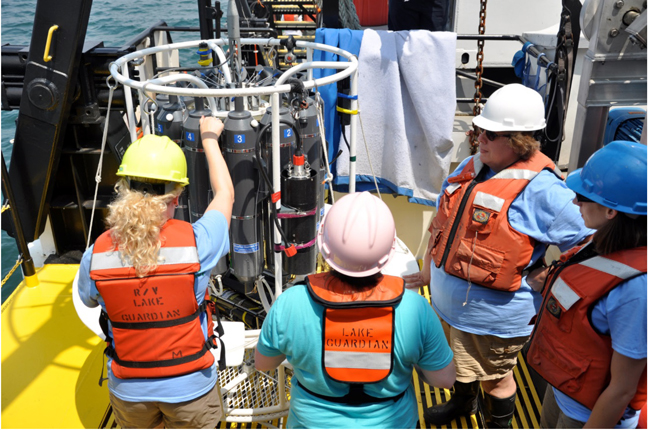
According to 2013 workshop evaluations from New York Sea Grant-led educator workshops— including field trips, classroom exercises, and hands-on learning with local, state and federal researchers—participants will change how and what they teach. Several have already involved students in local waterway clean-ups and stewardship activities to slow the spread of invasive species.
Pictured here are NYSG workshop participants aboard the U.S. Environmental Protection Agency's 180-foot R/V Peter L. Wise Lake Guardian. In July 2013, 15 educators from across five Great Lakes States—Illinois, Minnesota, Pennsylvania, Ohio and, of course, New York—boarded this research vessel for a week. It was the first time in five years that the R/V Guardian had been out on Lake Ontario for this "Shipboard and Shoreline Science Workshop" and it'll be another five before it comes around again (Photo: Paul C. Focazio, NYSG).
NYSG's Web Content Manager, Paul C. Focazio, shadowed the group and reported back with a series of blog posts, which, along with video and newspaper clips from local media, are featured in "On YouTube, On Blog: Teachers Participate in Research on Great Lakes."
For more "NYSG Great Lakes Coastal Youth Education" news, click on the "News/Topics" section in the left-hand side bar at www.nyseagrant.org/cyeducation.
NYSG Harmful Algal Bloom Workshops a Model for Helping Great Lakes Stakeholders (pdf)
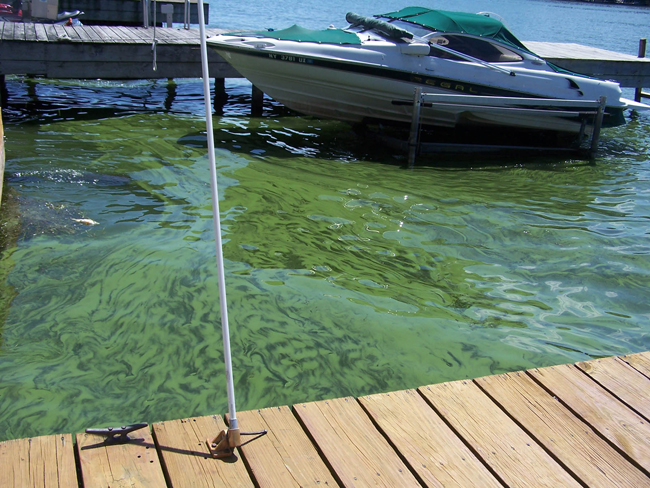
Several National Oceanic and Atmospheric Administration (NOAA) Oceanic and Atmospheric Research (OAR)-funded New York Sea Grant-organized Harmful Algal Bloom (HAB) workshops connected diverse stakeholders with HAB science experts to help mitigate the environmental and economic impacts of HAB outbreaks. A single Lake Ontario community - Sodus Point, NY - reported a $200,000 revenue loss from a 2010 HAB outbreak in 2010, like the one pictured above (Photo: SUNY ESF).
For more "NYSG Harmful Algal Bloom" news, click on the "News/Topics" section in the left-hand side bar at www.nyseagrant.org/habs.
NYSG Long Island Sound Mentor Teacher Program Encourages Local Watershed Literacy (pdf)
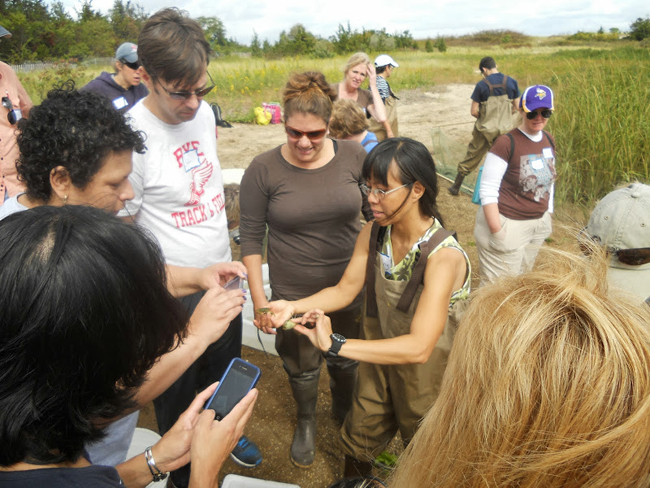
To increase public awareness of the Long Island Sound watershed, New York Sea Grant (NYSG) provides formal and informal K-12 educators in Westchester, Bronx, Queens, Nassau, and Suffolk counties with professional development workshop opportunities through the Long Island Sound Mentor Teacher Program. Long Island Sound Mentor Teacher Fanny Kleisler (pictured here) discusses the different kinds of marine arthropods found in Long Island Sound (including crabs, shrimp and lobsters) with attendees at the “Awesome Estuaries” workshop at Sunken Meadow State Park (Photo: NYSG/Amy Mandelbaum).
Since 2002 (Connecticut) and 2010 (New York), the Long Island Sound Mentor Teacher Program has conducted 37 workshops with more than 350 educators, and, through those educators, has reached more than 25,000 students.
For more on these efforts, see NYSG's related news item, "Volunteers Pitch in at LISS-designated Stewardship Areas."
And additional "NYSG's Long Island Sound / Marine Education" News is located at www.nyseagrant.org/lisound.
NYSG Launch Stewards Educating Boaters, Public to Help Stop Aquatic Hitchhikers (pdf)
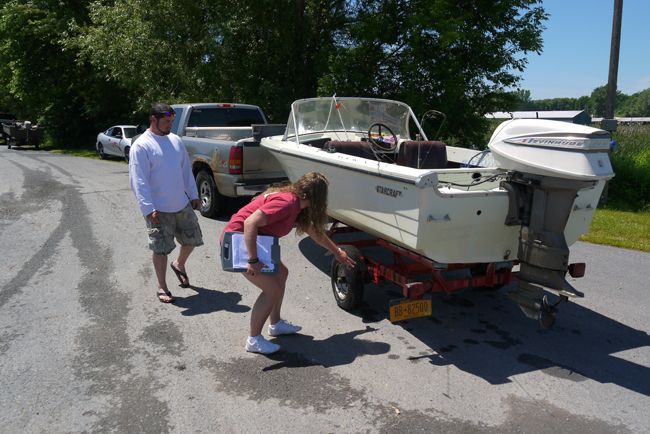
Due to the past success of New York Sea Grant-managed Waterfront Steward programs in Jefferson and Oswego counties, the Launch Steward program that began in 2012 expanded its educational impact and geographical outreach in 2013 to include Madison, Oneida, Onondaga and Wayne counties.
In 2013, NYSG's Launch Stewards, who educate boaters about watercraft inspection to reduce the spread of aquatic invasive species, conducted 2,166 inspections and educated 5,178 boaters (85 percent NYS-registered) (Photo: Megan Pistolese).
For more information on the success of this annual effort - including video footage, pictures and related news - see NYSG's article, "On YouTube: NYSG's Launch Stewards Educate on Aquatic Invasives."
The Launch Stewards section of NYSG's "Coastal Communities Development Program" resource site has news, fact sheets and other publications on stewardship and invasive species education at www.nyseagrant.org/ccdstewards.
Another one of NYSG's 2014 impact statements focuses on the program's various aquatic invasive species education efforts (pdf),
including the Launch Stewards program. Combined, these activities - which
reach diverse audiences to engage public participation in prevention and
restoration efforts - have involved more than 335,000 New Yorkers and
restored over 335 acres.
Hazard Resilience in New York Coastal Communities
NYSG Increasing Awareness of “Living Shorelines” for Erosion Protection (pdf)
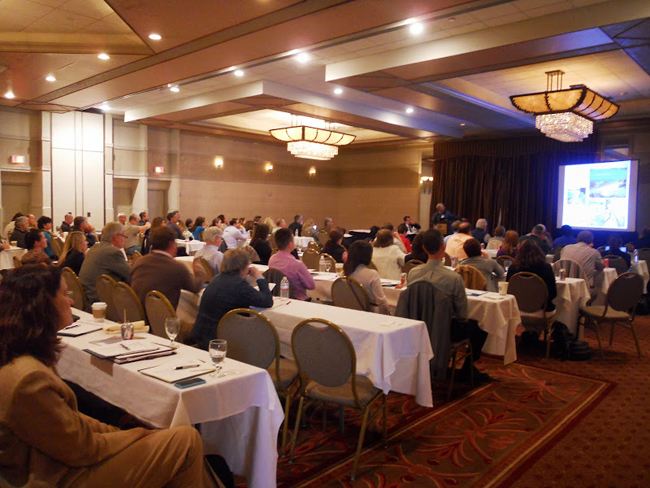
NYSG Living Shorelines for Coastal Erosion Protection in a Changing World workshop (Photo: NYSG/James Pearce).
In Spring 2013, New York Sea Grant began a climate change discussion with state and local officials, property owners and managers, marine consultants and contractors, and non-government organizations. The cornerstone of the talks was a technical workshop on "living shorelines," which addressed concerns over how and to what extent climate change could exacerbate coastal flooding and erosion problems in many areas.
Why is "living shorelines" such a hot topic? Well, for starters, one of the priorities of The National Oceanic and Atmospheric Administration's (NOAA) National Sea Grant College Program is to improve the resilience of coastal communities to hazards, including effects of climate change.
Second, many coastal communities are looking to “living shorelines” as the preferred method for dealing with erosion problems because of its environmental benefits and because its techniques are often considered more adaptable to potential impacts associated with climate change such as increased sea level rise.
For more on the discussions, including presentations and YouTube clips from the event, check out our related news item, "Living Shorelines: For Coastal Protection in a Changing World."
More on marine coastal hazards/processes and marinas at www.nyseagrant.org/marinecoastal. And additional content on climate change at www.nyseagrant.org/climate.
Resilient New York Communities & Economies
NYSG Nonpoint Education for Municipal Officials: Leading Inter-Municipal Water Quality Restoration (pdf)
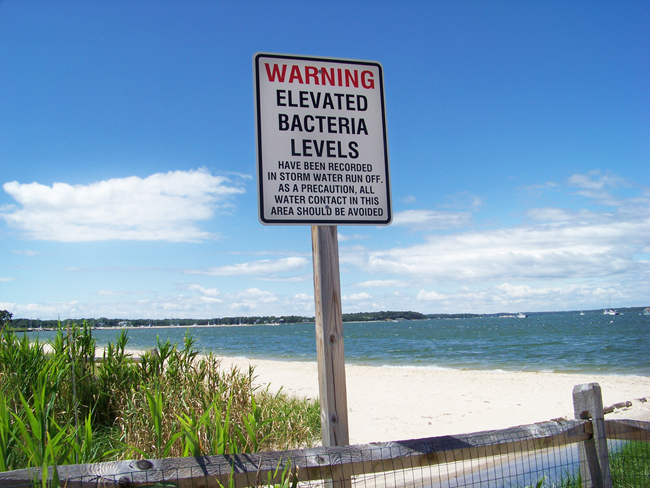
For nearly 15 years, New York Sea Grant's Nonpoint Education for Municipal Officials (NEMO) project has been informing and equipping municipalities with the tools they need to implement sustainable and cost-effective stormwater management programs.
"Providing education on municipal stormwater management and nonpoint source pollution control on Long Island in other locales through the National NEMO network is of vital importance to protecting our estuarine resources," says NYSG NEMO Program Manager Eileen Keenan.
Keenan offers technical expertise and assistance concerning the U.S. Environmental Protection Agency's Phase II Stormwater Program compliance on a regular basis to nearly 100 Long Island municipalities. In the Peconic Estuary, located on eastern Long Island, excessive levels of nitrogen and bacteria are a major challenge. To learn more on how NYSG's NEMO program has helped address this issue, see the related impact statement (pdf).
And for more on NYSG's Nonpoint Education for Municipal Officials Program, see www.nyseagrant.org/nemo - click on the "News/Topics" section in the left-hand sidebar.
PHOTO: Inter-municipal agreements ensure the effectiveness of natural resource protection. (Photo: NYSG NEMO/Eileen Keenan).
Sustainable New York Coastal Development
NYSG Hudson River Estuary Project Brings Accessibility to Those with Disabilities (pdf)
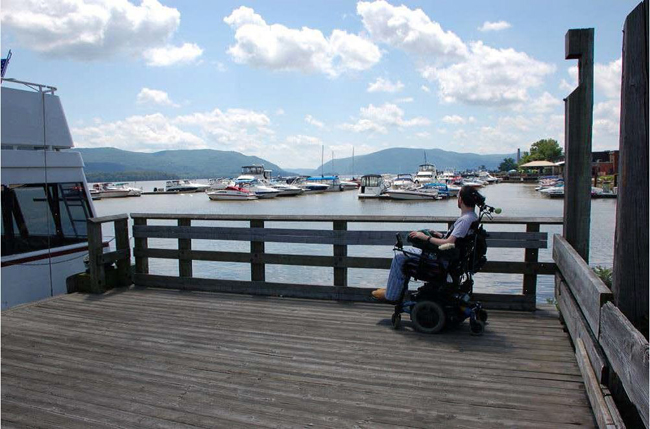
In 2013, to increase recreational access to New York’s waterfront resources for people with disabilities, New York Sea Grant (NYSG) partnered with the Northeast Americans with Disabilities Act Center (NADAC) at Cornell University to develop and deliver an assessment of 18 boat launches and adjacent beach areas located along 100 miles of shoreline on both sides of the Hudson River.
As detailed in a December 2013 report, thorough accessibility compliance evaluations were conducted at the selected 18 New York State Department of Environmental Conservation (NYSDEC)-supported sites. Recommendations were made to bring each site into compliance with the 2010 Standards for Accessible Design.
"Making sure that your place of business and the goods and services you offer are accessible to people with disabilities means your business will be more welcoming and accessible to other customers, too," says NYSG Hudson Estuary Specialist Nordica Holochuck.
PHOTO: An Independent Living Center Assessment Team Member enjoys the Newburgh waterfront. (Photo: Cornell University Northeast Americans with Disabilities Act Center)
For additional NYSG "Hudson River Estuary" education efforts, click the "New/Topics" link in the left-hand sidebar at www.nyseagrant.org/hriver.
NYSG Trawl Design Workshops Enhance Fisheries Management and Commercial Trawling (pdf)
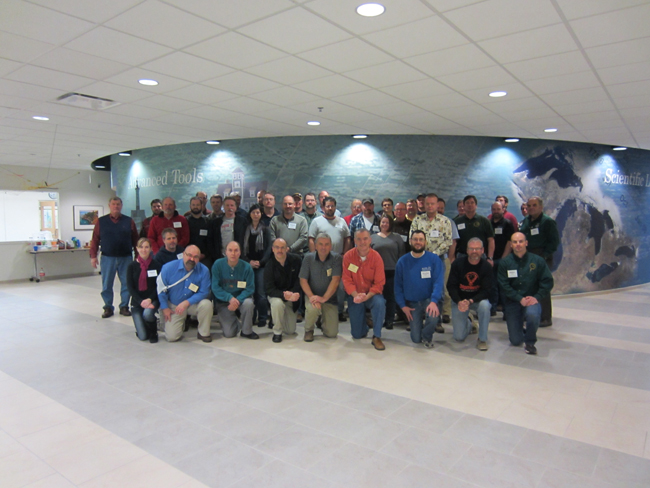
Bottom trawling - widely used to provide fish abundance information to the managers of the $4 billion Great Lakes fisheries - has been the focus of a series of New York Sea Grant-led workshops.
2013's NYSG Trawl Design Workshop featured an international group of fisheries managers and commercial trawlers (pictured above; Photo: Michigan Sea Grant) who have since improved their existing programs and also designed new initiatives. For more on a preceding workshop from 2011, see NYSG's related news item, "Trawl Workshop an Award-Winning International Exchange."
For additional NYSG "Great Lakes Sustainable Recreational and Commercial Fisheries" efforts, click the "New/Topics" link in the left-hand sidebar at www.nyseagrant.org/glsportfish.
NYSG Clean & Safe Boating Project A Model for Education and Industry Partnership (pdf)
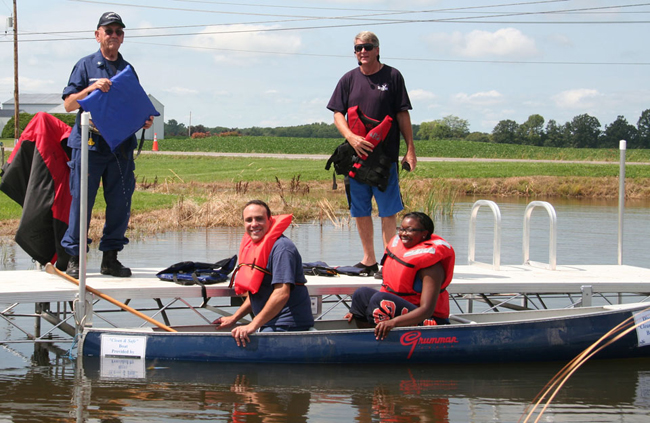
As of January 2014, over 500,000 boaters/potential boaters have seen New York Sea Grant's "Discover Clean & Safe Boating" campaign exhibit at some 50+ events in all of NY’s coastal regions - from New York City and the Hudson River to New York's Finger Lakes and Great Lakes regions. More than 60 media interviews have featured the project, which made its debut at 2008's Boating Industries Association (BIA) of Upstate New York show.
"This campaign sets the model for keeping the public current on required safety equipment, environmentally-sound boating practices, and methods to reduce the transport of invasive species," says NYSG's Coastal Recreation & Tourism Specialist Dave White.
For more on the reach of this campaign through 2013, see NYSG's related news item, "On YouTube: Discover Clean Boating Expands, is at City of Water Day in NYC."
Another one of NYSG's 2014 impact statements focuses on the program's various aquatic invasive species education efforts (pdf),
including clean and safe boating. Combined, these activities - which
reach diverse audiences to engage public participation in prevention and
restoration efforts - have involved more than 335,000 New Yorkers and
restored over 335 acres.
PHOTOS: Above: NYSG's Dave White, standing right, with U.S. Coast Guard/Auxiliary personnel at in-water demo; Below: 2013 NYSG Clean & Safe Boat (provided by Marathon Boat Group) at Empire Farm Days, the Northeast’s largest outdoor agricultural show (Photos: Brian P. Whattam)
And for more NYSG "Great Lakes Boating & Marine Trades" stories, click the "New/Topics" link in the left-hand sidebar at www.nyseagrant.org/marina.
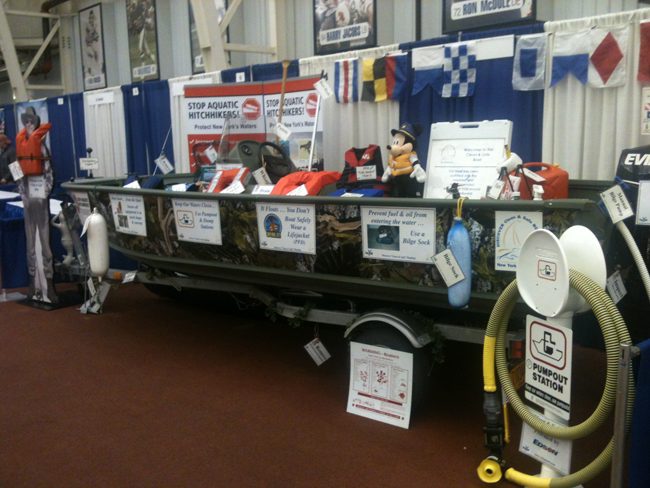
Safe & Sustainable New York Seafood Supply
NYSG Helping to Diversify Marketing of New York’s Family-Owned Fishing Businesses (pdf)

In 2013, Dock to Dish, a local entrepreneurial effort encouraged by New York Sea Grant, conducted a trial Community Supported Fisheries (CSF) business model. Dock to Dish Coordinator Sean Barrett is pictured above making a presentation to chefs at The Modern restaurant inside New York City's The Museum of Modern Art (Photo courtesy of Sean Barrett).
Community Supported Fisheries create the opportunity for the public to purchase seafood shares directly from commercial fishing enterprises. “Fishermen share many commonalities with small farmers," says NYSG Fisheries Specialist Antoinette Clemetson, "and we are seeking ways to work with fishing businesses to establish community supported fisheries programs such as those models that have been successfully applied on small farms.”
For a news archive on the "seafood throwdown" concept, see www.seagrant.sunysb.edu/articles/r/1189#seafoodthrowdown. Additional information about NYSG's Marine Fisheries efforts can be found via its related resource site, www.nyseagrant.org/marinefish - click on "News/Topics" in the left-hand sidebar.
